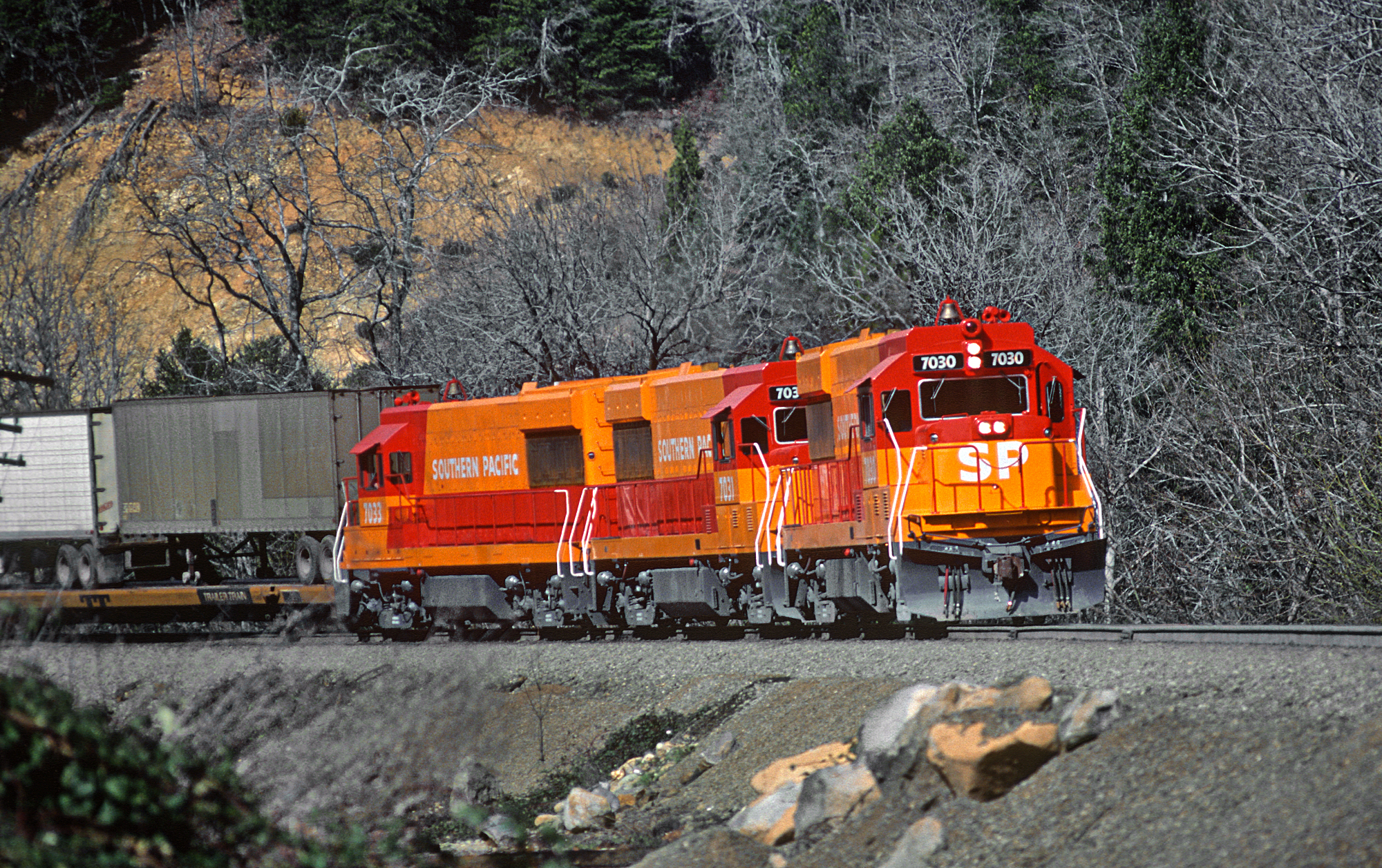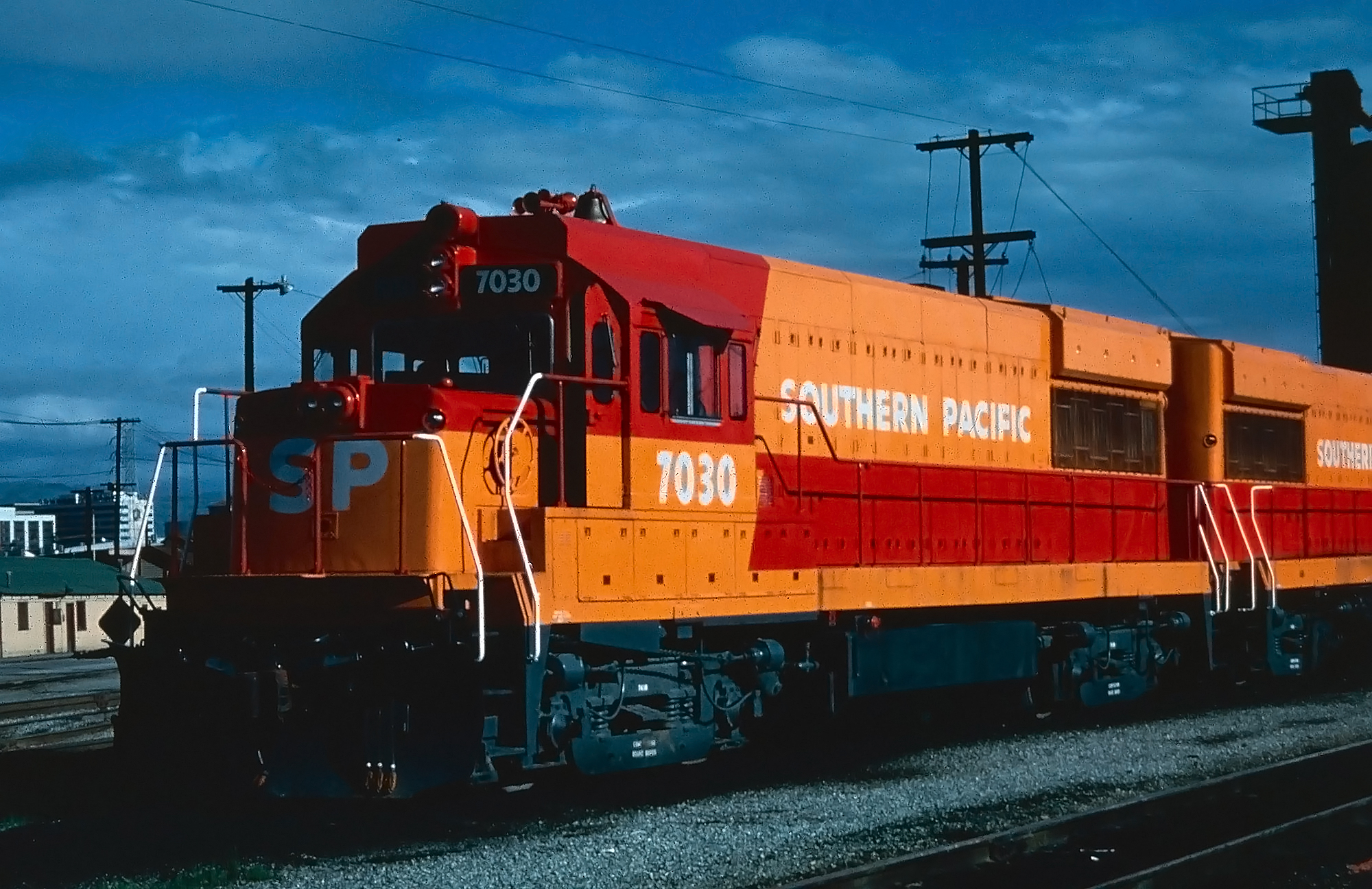MK "TE70-4S" Locomotives: Specs, Roster, Data Sheet
Published: July 11, 2024
By: Adam Burns
The evolution of railroad technology in the United States is marked by numerous innovations and introductions of diesel-electric locomotives, each defining an era of its own.
Among these models, the TE70-4S diesel locomotive created by Morrison-Knudsen stands out as a quintessential blend of robust engineering and innovative adaptation.
Sporting a distinctive paint scheme inspired by the red and orange hues of Southern Pacific's iconic Daylight passenger trains, these locomotives earned the moniker "Popsicle" due to the vibrant design.
Unfortunately, the four experimental units - numbered 7030-7033 - proved less than satisfactory in service. In 1987, after less than a decade in service, the locomotives were retired and utlimately scrapped.
 Three of Southern Pacific's new TE70-4S units, led by #7030, are on their inaugural run down the Sacramento River canyon in March, 1978. Unfortunately, #7032 had already been setout during the trip due to mechanical issues. Roger Puta photo.
Three of Southern Pacific's new TE70-4S units, led by #7030, are on their inaugural run down the Sacramento River canyon in March, 1978. Unfortunately, #7032 had already been setout during the trip due to mechanical issues. Roger Puta photo.Genesis
Founded in 1912, Morrison-Knudsen established itself as a behemoth in engineering and construction, gaining notable success through infrastructure projects around the globe.
By the latter half of the 20th century, the company expanded its horizons to remanufacture and rebuild locomotives, bringing forth a line of unique, purpose-built engines, which includes the TE70-4S.
The Concept
At its core, the TE70-4S was born out of the practical necessity to modernize and extend the lifecycle of older locomotives.
In 1977, Southern Pacific undertook an ambitious project by selling four of its decommissioned U25B locomotives to Morrison Knudsen for re-engineering.
These units were fitted with Swiss-built Sulzer V-12 engines, which offered 3000 horsepower, though derated to 2800 horsepower for optimal performance.
The transformation repurposed only a few original components, such as the trucks, traction motors, frame, main generator, cab, and nose.
The long hood was reconstructed, becoming 10 inches taller and 4 inches wider to accommodate the new Sulzer engine, giving it a GP30-like appearance over the cab roof area.
Technical Specifications
- **Power Plant:** The prime mover was the Sulzer 12ASV 25/30, an engine primarily utilized in marine and stationary applications since its introduction in 1969.
This robust four-stroke turbocharged engine boasted a maximum output of 3,240 horsepower (2.4 MW) at 1,000 RPM. The locomotives were derated to 2,800 horsepower (2.1 MW) for optimal performance.
- **Electrical Systems:** Retaining the GE GT598 D3A generators and GE 752 traction motors from the original U25B locomotives. Equipped with a 74:18 gear ratio the TE70-4S could produce a top speed of 70 mph.
- **Chassis and Carbody:** The new prime mover necessitated significant modifications to the cab, carbody, and underframe.
The reconstructed locomotives measured 60 feet 2 inches (18.3 meters) in length, 10 feet 7.5 inches (3.2 meters) in width, and stood 15 feet 10.875 inches (4.8 meters) in height. Each unit weighed 279,000 pounds (126,552 kilograms).
- **Bogie Configuration:** The locomotive is configured with a B-B axle arrangement, retaining its AAR Type Bs commonly found on U-boat models.
Heritage
| Number | Original SP Number | Second SP Number | Serial Number(s) | Original Build Date |
|---|---|---|---|---|
| 7030 | 7545 | 6745 | 34782 | 2/1964 |
| 7031 | 7517 | 6717 | 34687 | 3/1963 |
| 7032 | 7533 | 6733 | 34770 | 1/1964 |
| 7033 | 7552 | 6752 | 34789 | 3/1964 |
Practical Performance
The operational performance of the TE70-4S highlighted its dual capacity for heavy freight haulage and passenger service.
The combination of the Sulzer engine’s high horsepower and the GE traction system provided ample power for demanding tasks, while flexibility in speed and control made it an asset in varied applications.
Alas, the locomotives never performed as intended. The inaugural revenue run for the commenced on March 1, 1978. The four units were tasked with hauling a trailer-on-flatcar (TOFC) train from Seattle to Los Angeles, operating specifically between Portland and Los Angeles. Unfortunately, the journey was marred by the breakdown of one locomotive.
Adoption and Operational Life
Despite its capabilities, the TE70-4S did not see widespread adoption. A contributing factor to its limited proliferation was the relatively high cost of conversion compared to purchasing new locomotives from established manufacturers.
Nonetheless, the units that were produced served on various railroads, including those in the United States and overseas. The exemplified robust performance and longevity in service reassure that Morrison-Knudsen’s engineering efforts bore tangible fruit.
Legacy and Impact
Despite their striking appearance, the locomotives were plagued by unreliable performance, leading to their retirement in 1987 after less than a decade in service. Regrettably, none of the units were preserved.
The TE70-4S continues to hold a niche but notable position in the history of diesel locomotive development. It serves as a case study in innovative engineering solutions that leverage existing platforms to meet modern demands.
The principles applied in its design—sustainability, cost-efficiency, and resourcefulness—remain relevant in today’s engineering and manufacturing landscapes.
 A pair of Southern Pacific's experimental 2,800-horsepower TE70-4S units, circa 1983. There were four of these locomotives (7030–7033) manufactured by Morrison-Knudsen in 1977-1978 from former U25Bs, equipped with Sulzer (Switzerland) prime movers. The concept wasn't successful and the units were sold in 1987. Mike Bledsoe photo. American-Rails.com collection.
A pair of Southern Pacific's experimental 2,800-horsepower TE70-4S units, circa 1983. There were four of these locomotives (7030–7033) manufactured by Morrison-Knudsen in 1977-1978 from former U25Bs, equipped with Sulzer (Switzerland) prime movers. The concept wasn't successful and the units were sold in 1987. Mike Bledsoe photo. American-Rails.com collection.Conclusion
The TE70-4S remains a testament to the ingenuity and resourcefulness that define the locomotive rebuilding sector, and is certainly one of the more interesting early rebuilds of a first-generation model.
It is a symbol of how practical needs can drive innovative adaptations, resulting in machinery that not only meets but exceeds performance expectations within available constraints.
As the railway industry continues to evolve, the lessons drawn from the TE70-4S emphasize the ongoing relevance of adaptive reuse and the valorization of existing technological assets.
The locomotive, standing as a bridge between past and present, showcases how historical engineering ingenuity can inform and guide contemporary and future advancements.
Recent Articles
-
Nevada's - Murder Mystery - Dinner Train Rides
Jan 07, 26 02:12 PM
Seamlessly blending the romance of train travel with the allure of a theatrical whodunit, these excursions promise suspense, delight, and an unforgettable journey through Nevada’s heart. -
West Virginia's - Murder Mystery - Dinner Train Rides
Jan 07, 26 02:08 PM
For those looking to combine the allure of a train ride with an engaging whodunit, the murder mystery dinner trains offer a uniquely thrilling experience. -
Kansas's - Murder Mystery - Dinner Train Rides
Jan 07, 26 01:53 PM
Kansas, known for its sprawling wheat fields and rich history, hides a unique gem that promises both intrigue and culinary delight—murder mystery dinner trains. -
Michigan's - Wine Tasting - Train Rides
Jan 07, 26 12:36 PM
In this article, we’ll delve into the world of Michigan’s wine tasting train experiences that cater to both wine connoisseurs and railway aficionados. -
Indiana's - Wine Tasting - Train Rides
Jan 07, 26 12:33 PM
In this article, we'll delve into the experience of wine tasting trains in Indiana, exploring their routes, services, and the rising popularity of this unique adventure. -
South Dakota's - Wine Tasting - Train Rides
Jan 07, 26 12:30 PM
For wine enthusiasts and adventurers alike, South Dakota introduces a novel way to experience its local viticulture: wine tasting aboard the Black Hills Central Railroad. -
Kentucky Thomas The Train Rides
Jan 07, 26 12:26 PM
If you’ve got a Thomas fan in the house, Day Out With Thomas at the Kentucky Railway Museum is one of those “circle it on the calendar” weekends. -
Michigan's Thomas The Train Rides
Jan 07, 26 12:10 PM
If you’ve got a Thomas fan in the house, few spring outings feel as “storybook-real” as Day Out With Thomas™ at Greenfield Village in Dearborn, Michigan. -
Texas Dinner Train Rides On The TSR!
Jan 07, 26 11:36 AM
Today, TSR markets itself as a round-trip, four-hour, 25-mile journey between Palestine and Rusk—an easy day trip (or date-night centerpiece) with just the right amount of history baked in. -
Iowa Dinner Train Rides In Boone!
Jan 07, 26 11:06 AM
If you’ve ever wished you could pair a leisurely rail journey with a proper sit-down meal—white tablecloths, big windows, and countryside rolling by—the Boone & Scenic Valley Railroad & Museum in Boon… -
Wisconsin Dinner Train Rides In North Freedom!
Jan 06, 26 10:18 PM
Featured here is a practical guide to Mid-Continent’s dining train concept—what the experience is like, the kinds of menus the museum has offered, and what to expect when you book. -
Pennsylvania Dinner Train Rides In Boyertown!
Jan 06, 26 06:48 PM
With beautifully restored vintage equipment, carefully curated menus, and theatrical storytelling woven into each trip, the Colebrookdale Railroad offers far more than a simple meal on rails. -
North Carolina ~ Murder Mystery ~ Dinner Train Ride
Jan 06, 26 11:26 AM
While there are currently no murder mystery dinner trains in the Tarheel State the Burgaw Depot does host a murder mystery dinner experience in September! -
Florida's - Murder Mystery - Dinner Train Rides
Jan 06, 26 11:23 AM
Florida, known for its vibrant culture, dazzling beaches, and thrilling theme parks, also offers a unique blend of mystery and fine dining aboard its murder mystery dinner trains. -
New Mexico's - Wine Tasting - Train Rides
Jan 06, 26 11:19 AM
For oenophiles and adventure seekers alike, wine tasting train rides in New Mexico provide a unique opportunity to explore the region's vineyards in comfort and style. -
Ohio's - Wine Tasting - Train Rides
Jan 06, 26 11:14 AM
Among the intriguing ways to experience Ohio's splendor is aboard the wine tasting trains that journey through some of Ohio's most picturesque vineyards and wineries. -
Connecticut's Thomas The Train Rides
Jan 06, 26 11:06 AM
For 2026, the tour stop at Essex brings Thomas (and Percy, too) to the historic Valley Railroad for a full day of events for the kids. -
Maryland's Thomas The Train Rides
Jan 06, 26 11:00 AM
In 2026, the B&O Railroad Museum in Baltimore welcomes the Let’s Rock, Let’s Roll Tour with four event days that combine a Thomas-themed excursion with other activities. -
Tennessee's Thomas The Train Rides
Jan 06, 26 10:51 AM
Set on the grounds of one of the Southeast’s best-known operating railroad museums, the Thomas the train event blends kid-friendly fun with the unmistakable sights, sounds, and atmosphere of a real wo… -
Georgia's Thomas The Train Rides
Jan 06, 26 10:44 AM
Day Out With Thomas is set to roll back into Cordele in 2026, bringing Thomas the Tank Engine and a full family festival to the SAM Shortline at Georgia Veterans Memorial State Park.




















